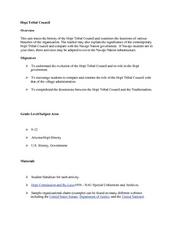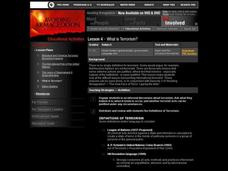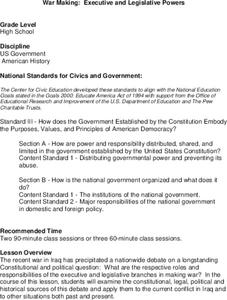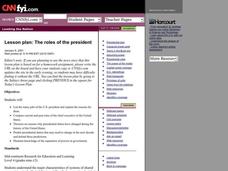Council for Economic Education
The Role of Government: The Federal Government and Fiscal Policy
Give learners a crash course in balancing the books on the United States federal government level with an economics and government resource. Class members engage in a warm-up discussion and brainstorming session before answering...
School Improvement in Maryland
Dividing the Powers of Government
Who does what? To develop an understanding of the balance of power between the US federal and state governments, class members research responsibilities in terms of legal systems, security issues, economic activities, lawmaking, and...
Curated OER
Hopi Tribal Council
Focusing on the differences between traditional Hopi government and the Hopi Tribal Council, this resource is a good addition to your unit on Native American culture. Learners conduct Internet research, analyze primary source photos, and...
Curated OER
Participating in State and Local Government
Students analyze the structure, organization, and powers of State legislatures. They outline the overall shape of the office of the governor.
Students analyze the structure of local governments as creations of the State. They describe...
Curated OER
Comparing Governments
Twelfth graders research and discuss the different elements of the governments of China, Great Britain, Mexico and the United States. They discuss the differences between the various governments and create explanation cards for each type...
iCivics
Mini-Lesson: Executive Orders
Can the President of the United States pass a law all by himself? Scholars investigate the concept of the executive order in regards to the powers of the presidency. They use current issues and events to monitor media bias while also...
Curated OER
Avoiding Armageddon
PBS has written a series of lessons on avoiding Armageddon. This is instructional activity 4 of 5 and focuses on defining terrorism. Upper graders watch episode 3 of "Avoiding Armageddon - The New Face of Terror," read how terrorism is...
Curated OER
Leaders in the Judicial Branch
Students examine the leadership roles and qualities of members of the judicial branch in public life. They view and discuss video clips from a federal judge and two Supreme Court judges.
Curated OER
War Making: Executive and Legislative Powers
Young scholars examine Constitution and what it says about war-making power, contrast roles and responsibilities of executive and legislative branches of government when it comes to making war, become familiar with important 20th and...
Curated OER
Government: The Power Grab
Students are able to identify the departments and agencies within the executive branch that enforce energy policy. They are able to describe potential concerns that the executive branch must address when developing energy policy.
Curated OER
George Washington and the Rule of Law
learners compare The rule of law with the rule of men and consider life under each of these types of governments.In this government instructional activity, students read a primary source to examine the importance of the rule of law.They...
Curated OER
The Civil War
Although we currently focus on Abraham Lincoln's positive contributions in creating a more equal society, the truth is that Lincoln was actually a controversial character in his time! After studying the Civil War, give your high...
Curated OER
Separation of Powers: Checks and Balances
Students discuss the reasons for separation of powers between the branches of government. They list the branches and identify the powers and functions of each.
C-SPAN
How A Bill Becomes A Law
Seven steps are required for a bill to become a United States law. The Families First Coronavirus Response Act (H.R. 6201) is used as a model for the process of how a bill becomes a law. Class members work independently through a Google...
Curated OER
The Supremes
Students discuss steps cases go through to reach Supreme Court, examine Bill of Rights, and rank rights in order of importance to them. Students then research Supreme Court case dealing with one of first ten amendments, and write about...
Curated OER
Ports in the Storm
Students explore national security issues related to the possibility of a Dubai-owned company operating an American port. Opinions are solicited and debated.
Curated OER
I 695 (The 30$ License Tabs Initiative)
Students research the bill I 695 issue. They discuss the topic before they research the issue of I 695. Students discuss how new laws are always being created and the differences in opinion about these laws. They see how this initiative...
Federal Reserve Bank
The Story of the Federal Reserve: High School Lesson Plan
Is there a bank for the banks? Pupils analyze the complexities of the Federal Reserve system by breaking it down into easy-to-understand sections. Step-by-step investigation using flow charts and graphs of how the monetary system works...
Curated OER
Telegram from Senator Joseph McCarthy to President Harry S. Truman
Students research the McCarthy hearings to determine the following: time frame of hearings, how they were broadcast, how the press reacted, and how the American people reacted in light of the Korean Conflict and the Cold War.
Curated OER
The Roles of the President
Young scholars list the many jobs of the U.S. president and explain the reasons for them. They compare current and past roles of the chief executive of the United States.




